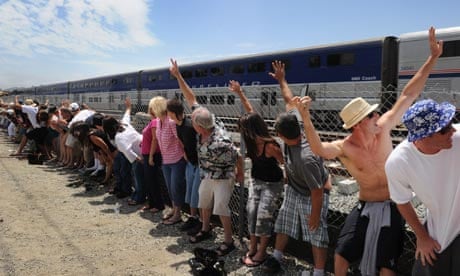The best moonie of all time wasn't a moonie at all. At the Brits in 1996, Jarvis Cocker took to the stage as Michael Jackson sang Earth Song, bending over while crowds of wide-eyed children milled around weeping "what about us?", Cocker waggled his hands about his bottom, like a duck paddling to stay afloat. Crucially, there was no nudity. It was maximum ridicule with minimum vulgarity.
The same can't be said for Elton John. There he was, earlier this week, on his yacht on the French Riviera, dropping his shorts to salute Michael Caine's passing ship. It was the full moon, and not for the first time. Last week, John also went bottoms up with his friend David Walliams as Simon Cowell sailed past.
The photos are a reminder of why mooning is such a versatile gesture – shocking, silly, exuberant, grotesque, as embarrassing for the mooner as the mooned-at. But it remains popular: Anne Hathaway, Gerard Butler and Robbie Williams have done it; the partner of Olympic cyclist Dani King bared his bottom while out partying last week; a man in Manitoba was arrested for mooning last month. And in June Madonna revealed her G-string at a concert in Rome.
Adults often seem convinced the trend has tanked, but that's almost certainly because we're not at school any more. The period in our lives when people feel compelled to press their naked bottom against a window does, thankfully, end. (See also: wedgies, goosing, love bites.)
The word mooning was coined relatively recently, in the early 60s – playing on "moon", a term for buttocks that has existed since the 1700s. But the act has been recorded for millennia. It has often been used to rile enemies; during the fourth crusade, for instance, the Byzantines showed their bottoms en masse to fleeing Europeans. And it enables ordinary people to express anger towards the privileged. In 2000, a group of anarchists organised a Moon Against the Monarchy event outside Buckingham Palace – although sadly the planned "2,000-bum salute" featured just four. And earlier this year an Australian barman was fined $750 after running alongside the Queen's motorcade with his national flag clenched artfully between his cheeks.
It's not always political, of course. In Laguna Niguel, California, there's an annual event at which people bare their backsides at passing trains; in 2008, 10,000 joined in, and police descended. There have long been questions around mooning's legality, and these were discussed in depth in the US state of Maryland in 2006, when it was decided that although a man's moonie had been "disgusting" and "demeaning", it was not illegal, since it didn't involve exposure of genitalia. The trouble is that bending down, bottom aloft, can be disorientating. You never know quite what might be exposed. Best to follow Jarvis's lead. Keep those trousers on.
So where do you stand on mooning – funny or offensive?

Comments (…)
Sign in or create your Guardian account to join the discussion